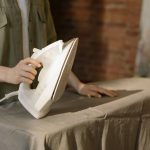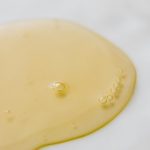You can get wrinkles out of your polyamide clothing in five easy ways. Use a steamer to gently smooth creases without damage. Try placing a damp towel over wrinkles, pressing gently, then air drying. If needed, iron on low heat with a cloth between the iron and fabric. Hanging clothes in a steamy bathroom also helps relax fibers, and wrinkle release sprays offer a quick fix. Keep going to discover more details on each method.
Table of Contents
Key Takeaways
- Use a steamer held a few inches away to gently remove wrinkles and refresh polyamide fabric without damage.
- Place a damp towel over the wrinkled garment, press gently, then air dry to smooth out creases.
- Iron on low heat with a pressing cloth on the reverse side to avoid shiny marks and fabric damage.
- Hang polyamide clothes in a steamy bathroom during a hot shower to relax fibers and reduce wrinkles naturally.
- Lightly mist wrinkle release spray on wrinkled areas, then smooth fabric with hands for quick crease removal.
Use a Steamer for Gentle Wrinkle Removal
While ironing can sometimes damage polyamide fabrics, using a steamer offers a gentle and effective way to remove wrinkles.
You just need to hang your garment on a sturdy hanger and slowly run the steamer’s nozzle over the fabric. The steam relaxes the fibers, smoothing out wrinkles without touching the material directly.
Make sure to keep the steamer a few inches away to avoid water spots or overheating. Move the steamer in downward strokes, focusing on the most creased areas.
Steaming not only removes wrinkles but also refreshes your clothing by eliminating odors. Plus, it’s quick and safe for delicate polyamide blends.
Steaming refreshes clothes by removing odors and wrinkles, offering a quick, safe option for delicate polyamide fabrics.
With this method, you’ll keep your clothes looking crisp without risking damage from a hot iron.
Try the Damp Towel Method
If you don’t have a steamer on hand, you can try the damp towel method to remove wrinkles from your polyamide clothing.
Lay your wrinkled garment flat on a clean surface. Then, take a clean towel, dampen it slightly with water, and place it over the wrinkled areas.
Press down gently with your hands to smooth out the fabric. Let the towel sit on the garment for about 10 to 15 minutes, allowing the moisture to relax the fibers.
Afterward, hang the clothing to air dry completely, ensuring wrinkles fade as it dries.
This method is simple, doesn’t require special tools, and works well for delicate polyamide fabrics that can’t handle high heat.
Iron Polyamide With Care
When you choose to iron polyamide clothing, you’ll need to adjust your iron to a low heat setting to prevent damaging the delicate fabric. Use a pressing cloth between the iron and the garment to avoid direct contact. Always iron on the reverse side and move the iron gently to smooth out wrinkles without stretching the fabric.
| Setting | Action | Tip |
|---|---|---|
| Low Heat | Use iron carefully | Prevents melting or burning |
| Pressing Cloth | Place between fabric | Protects from direct heat |
| Reverse Side | Iron inside out | Avoids shiny marks |
Following these steps guarantees your polyamide clothing stays wrinkle-free and in great shape.
Hang Clothes in the Bathroom During a Hot Shower
Because the steam from a hot shower relaxes fabric fibers, hanging your polyamide clothes in the bathroom during a shower can help reduce wrinkles effectively.
Simply place your wrinkled garment on a hanger and hang it on a hook or towel rack away from direct water contact. The warm, moist air softens the fibers, allowing wrinkles to relax and smooth out naturally.
Make sure your bathroom door stays closed to trap steam and maximize humidity. After your shower, leave the clothes hanging until they’re dry to prevent new wrinkles from forming.
This method is gentle, avoids heat damage, and requires no additional tools. It’s a convenient, energy-saving way to refresh your polyamide clothing without ironing or steaming directly.
Utilize a Wrinkle Release Spray
A wrinkle release spray can quickly refresh your polyamide clothing without the hassle of ironing.
Simply lay your garment flat or hang it up, then lightly mist the spray over the wrinkled areas. Gently tug and smooth the fabric with your hands to help release the creases.
The formulation works by relaxing the fibers, making wrinkles fade as the fabric dries. It’s a great option when you’re short on time or don’t want to risk heat damage from an iron.
Make sure to follow the product instructions and test the spray on a small, hidden area first to avoid discoloration.
Using a wrinkle release spray is an easy, effective way to keep your polyamide clothes looking crisp and fresh with minimal effort.
Frequently Asked Questions
Can Polyamide Clothing Be Machine Washed Without Damaging the Fabric?
You can machine wash polyamide clothing, but use a gentle cycle with cold water to avoid damage. Avoid high heat when drying, and always check the care label to keep your fabric looking its best.
How Do I Prevent Polyamide Clothes From Wrinkling During Storage?
To prevent pesky polyamide pleats, you should store your clothes carefully. Choose cushioned hangers, avoid overcrowding, and keep items loosely folded. This simple strategy greatly stops stubborn wrinkles from sneaking into your storage space.
Are There Any Specific Detergents Recommended for Polyamide Fabrics?
You should choose mild, gentle detergents without bleach or fabric softeners for polyamide fabrics. These protect the fibers and maintain elasticity. Look for products labeled safe for synthetics or delicate fabrics to keep your clothes in great shape.
Can Polyamide Clothing Be Tumble Dried Safely?
Tumble drying polyamide? Tread thoughtfully! Too much temperature turns textures tough. To protect your polyamide pieces, use a low-heat setting or skip the dryer altogether, opting for air drying to avoid damage and maintain fabric finesse.
How Long Does Polyamide Fabric Typically Last With Regular Wear?
You can expect polyamide fabric to last around 2 to 5 years with regular wear. Its durability depends on care, washing frequency, and exposure to heat or sunlight, so taking good care will extend its lifespan.
- The Use of Nonwovens in Construction and Civil Engineering - July 11, 2025
- The Use of Nonwovens in Construction and Civil Engineering - July 11, 2025
- The Use of Nonwovens in Construction and Civil Engineering - July 11, 2025







